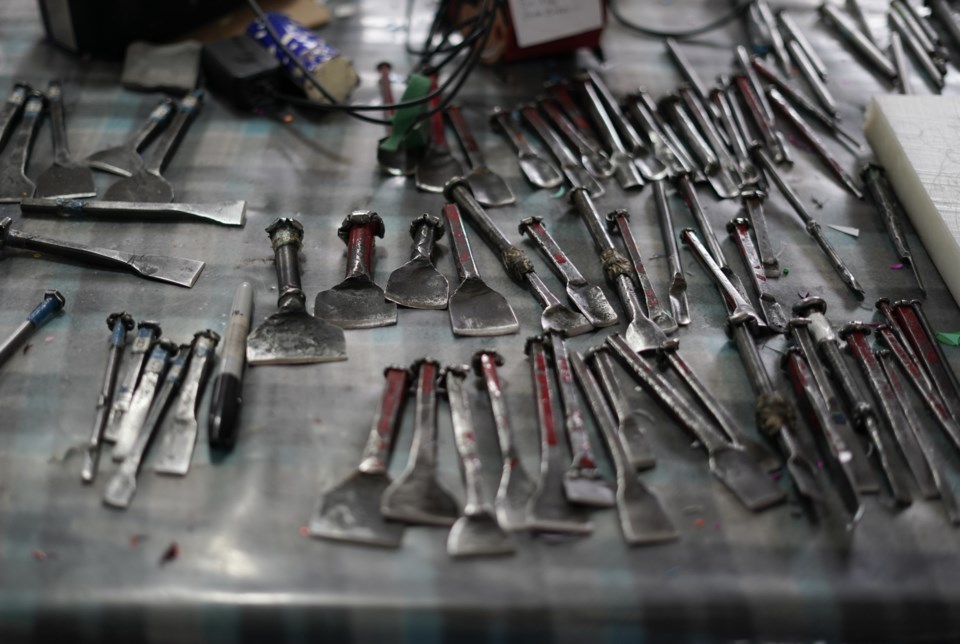XOCHIMILCO, Mexico (AP) — Mexican artisans are struggling to preserve the traditional manufacture of paper cut-out decorations long used in altars for the Day of the Dead.
Defying increasingly popular mass-production techniques, second-generation paper cutter Yuridia Torres Alfaro, 49, still makes her own stencils at her family’s workshop in Xochimilco, on the rural southern edge of Mexico City.
As she has since she was a child, Torres Alfaro punched stunningly sharp chisels into thick piles of tissue paper at her business, ‘Papel Picado Xochimilco.’
While others use longer-lasting plastic sheets, laser cutters or pre-made stencils, Torres Alfaro does each step by hand, as Mexican specialists have been doing for 200 years.
In 1988, her father, a retired schoolteacher, got a big order for sheets — which usually depict festive skeletons, skulls, grim reapers or Catrinas — to decorate city government offices.
“The business was born 34 years ago, we were very little then, and we started helping in getting the work done," Torres Alfaro recalled.
Begun in the 1800s, experts say ‘papel picado’ using tissue paper is probably a continuation of a far older pre-Hispanic tradition of painting ceremonial figures on paper made of fig-bark sheets. Mexican artisans adopted imported tissue paper because it was cheap and thin enough so that, with sharp tools, extreme care and a lot of skill, dozens of sheets can be cut at the same time.
But the most important part is the stencil: its design designates the parts to be cut out, leaving an intricate, airy web of paper that is sometimes strung from building or across streets. More commonly, it is hung above Day of the Dead altars that Mexican families use to commemorate — and commune with — deceased relatives.
The holiday begins Oct. 31, remembering those who died in accidents; it continues Nov. 1 to mark those died in childhood, and then those who died as adults on Nov. 2.
Traditionally, the bright colors of the paper had different meanings: Orange signified mourning, blue was for those who drowned, yellow was for the elderly deceased and green for those who died young.
But many Mexicans — who also use the decorations at other times of year, stringing them at roof-height along streets — now prefer to buy plastic, which lasts longer in the sun and the rain.
Still other producers have tried to use mass-produced stencils, which means that tens of thousands of sheets might bear exactly the same design.
“Stencils began to appear for making papel picado, because it is a lot of work if you have to supply a lot of people,” said Torres Alfaro, who still hand-cuts her own stencils with original designs.
“We wanted to keep doing it the traditional way, because it allows us to make small, personalized lots, and keep creating a new design every day,” she says.
Another rival was the U.S. holiday Halloween, which roughly coincides with Day of the Dead, Because it is flashier and more marketable — costumes, movies, parties and candy — it has gained popularity in Mexico.
“For some time now, there has been a bit more Halloween,” said Torres Alfaro. “We do more traditional Mexican things. That is part of the work, to put Mexican things in papel picado. If we do Halloween things, it's only on order" from customers.
Still others have tried to use 21st-century technology, employing computer-generated designs and laser cutters.
But Torres Alfaro says that concentrating so much on the cutting leaves out the most important part: the delicate webs of paper left behind.
“There are some laser machines that are gaining popularity, but we have checked them and the costs are the same, the machines still cut hole-by-hole and they can't cut that many sheets,” she said.
“The (ready-made) stencils and the laser machine have their downsides,” she said. “Papel picado is based on what can be cut, and what can't, and that is the magic of papel picado.”
Fernanda Pesce, The Associated Press



